This weekend was around -25 degrees with a wind chill of -65 on Mt. Washington. We are in a bit of a cold snap here in the White Mountains and it seems like this would be a great time for some helpful hints on how to keep your hands warm while ice climbing!
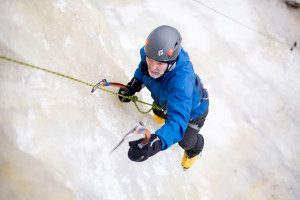
Keeping your hands warm while ice climbing takes some discipline.
If you have spent some time on the ice, you are sure to notice that your hands will get cold much quicker than while you are hiking into the cliff, or packing your bag, or while you are resting at the base of the climb. Why is this? There are several variables that contribute to cold hands that we will break down individually here.
1) First of all, our hands are typically below our heart. Our heart is used to pumping blood more or less down to our extremities. When we are climbing, our arms are now above our heart for quite some time. I bet if you held your arms above your head in your living room, eventually you would feel some tingling. We are so focused on our climbing that we do not notice this. Our hands are not getting the blood supply that they are used to getting in everyday life. Blood brings warmth to the area. We can combat this by “shaking out” every now and then on a climb. This is usually best done when you are at a good stance or rest. Sink your ice tool in well, arrange a restful or secure stance, and then hang one hand below your heart for a few seconds, then repeat with the other hand. This will get some blood flow and warmth back to your hands as well as rest your forearms muscles.
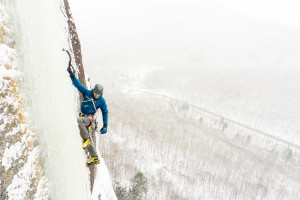
Shaking out your arms below your heart gets blood flow back to your hands and fingers, thus rewarming them.
2) What happens when you get nervous or scared while climbing? Aside from possibly having to empty your shorts after the pitch, our natural reaction is to grip our tools, or the rock, or our partner with a white knuckle death grip. In reality this actually wears out our muscles quicker and gives us only a small amount of added security. While swinging your ice tools use a firm but relaxed grip. Once you have a good “stick” relax the grip and hang on the pommel of the ice tool with your pinky finger. When we over-grip, we end up diminishing circulation to our fingers and also put extra strain on our muscles.
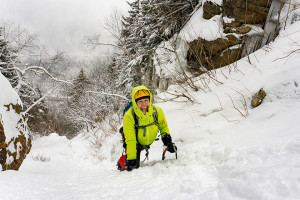
Relax and enjoy the climb! Loosen that grip!
3) Choosing the correct glove for the weather is key and takes some experience to dial in. Our common sense tells us that if our hands are cold, we need to put on heavier gloves or mittens. When you grip your tools, heavier gloves may actually be doing you a disservice. When you bend your fingers around your ice tool, the fabric and insulation has to also bend. When you have more fabric, it will begin to bunch up between your ice tool and your fingers. You not only have to work a little harder to grip your tool, but all of that fabric can also begin to diminish circulation. Sometimes less is more. I can recall on many occasions where switching to a lighter glove actually warmed up my hands. Keep this in mind. It may be worth experimenting with!
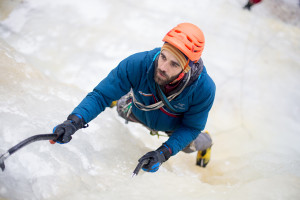
Lighter gloves can sometimes be warmer!
4) Start the climb with warm hands. This sounds like obvious advice but it is easy to go bare handed while putting on your crampons, racking your gear, tying knots, or fiddling with your backpack before the climb. In your excitement to begin the climb, you may jump right in without fully warming your hands back up. Your hands are unlikely to warm up while climbing so set yourself up for success.
5) Take care of your hands at the belay. Have a pair of mittens handy to belay with. I like to keep any pair of gloves or mittens inside my jacket to keep them warm and dry so when I switch, I am not rewarming a new pair of gloves or mittens.
6) Keep eating. The process of metabolism creates heat. You have to keep the fire stoked throughout the day to keep your core temperature and energy up. If your core is warm, your body won’t have to keep blood close to the vital org
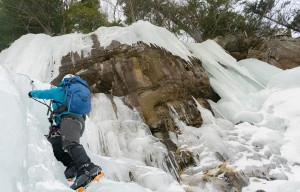
Get out there and change your perspective!
ans and can pump it out to our extremities to keep them warm.
Now that you have some new tools in your toolbox, its time to go give them a try! Ice season is short, so go get it while it lasts!

 We are proud to work with the Department of Agriculture, the White Mountain National Forest and the Androscoggin Ranger District where we are authorized outfitter guides.
We are proud to work with the Department of Agriculture, the White Mountain National Forest and the Androscoggin Ranger District where we are authorized outfitter guides.
